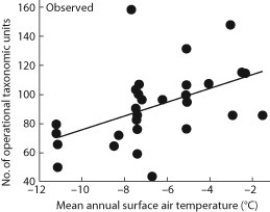Multiple Choice
As fungi play important roles in ecosystem processes as decomposers and symbiont partners, scientists are interested in understanding how global climate change may affect fungal diversity. In 2007-2008, scientists visited the maritime Antarctic, an area of the Southern Hemisphere that is noted to be warming the fastest, to conduct a survey of fungal diversity along a climatic gradient (the most prevalent weather conditions of a region along an incline) . Twenty-nine soil samples were taken along the gradient. Fungal diversity was measured in operational taxonomic units (OTUs) ; one OTU = one cluster, or group, of organisms. Here is a portion of the data collected:
 Source: Newsham, K. K., Hopkins, D. W., Carvalhais, L. C., Fretwell, P. T., Rushton, S. P., O'Donnell, A. G., & Dennis, P. G. (n.d.) . Relationship between soil fungal diversity and temperature in the maritime Antarctic. Nature Climate Change, 6, 182-186.
Source: Newsham, K. K., Hopkins, D. W., Carvalhais, L. C., Fretwell, P. T., Rushton, S. P., O'Donnell, A. G., & Dennis, P. G. (n.d.) . Relationship between soil fungal diversity and temperature in the maritime Antarctic. Nature Climate Change, 6, 182-186.
-Usable (liquid) water sources in the maritime Antarctic are directly related to air temperatures. Suppose scientists observe climate cooling in the maritime Antarctic over a 10-year period. At the end of the 10 years, scientists revisit the same site to study effects of climate cooling. Considering temperature and water stress tolerance of these organisms, which would be most likely to continue surviving?
A) lichens
B) angiosperms
C) ferns
D) conifers
Correct Answer:

Verified
Correct Answer:
Verified
Q1: About 80% of plants have mycorrhizae linking
Q2: Ferns and mosses are similar because both<br>A)
Q3: The intimate, mutually beneficial association formed between
Q4: The main causes of the loss of
Q6: In all plants, the zygote and earliest
Q7: Which of the following features would you
Q8: Which of the following characteristics tends to
Q9: In plants, the vascular tissue that consists
Q10: Mycorrhizal fungi are sometimes purposely introduced to
Q11: Which structure is found in angiosperms but